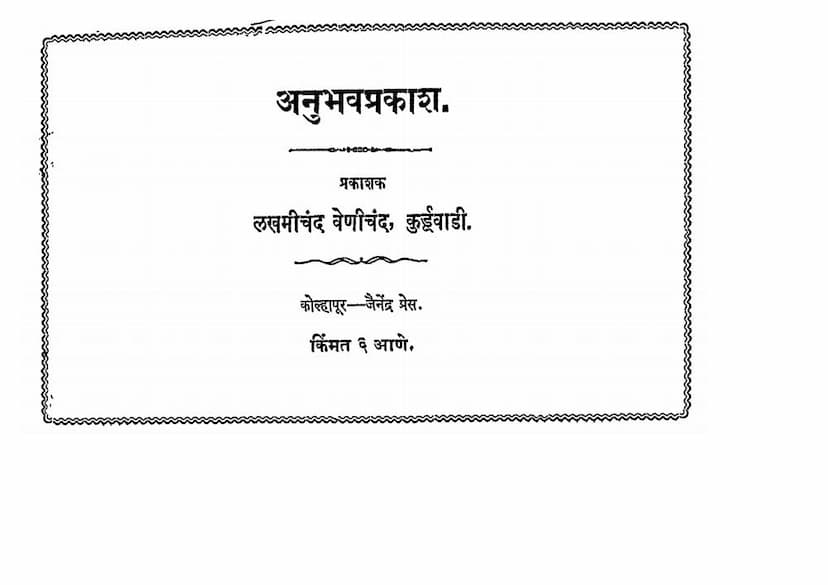Anubhav Prakash
Added to library: September 1, 2025

Summary
This is a comprehensive summary of the Jain text "Anubhav Prakash" (अनुभवप्रकाश) by Lakhmichand Venichand, based on the provided pages:
Book Title: Anubhav Prakash (अनुभवप्रकाश) Author: Lakhmichand Venichand Publisher: Lakhmichand Venichand Core Theme: The central theme of "Anubhav Prakash" is the direct, experiential realization (Anubhav) of the true self (Atman) as the path to liberation and eternal bliss. It emphasizes that true happiness and freedom come from within, through self-knowledge and the shedding of external attachments and delusions.
Key Concepts and Teachings:
- The True Self (Atman): The book describes the soul as intrinsically pure, blissful, and possessing infinite qualities (Anantgunmay). It is characterized by consciousness (Chidanand), knowledge (Gyan), and perception (Darshan).
- Ignorance and Delusion (Avidya/Moha): The primary cause of suffering and entanglement in the cycle of birth and death (Samsara) is ignorance of one's true nature and the mistaken identification with external, non-self entities (Parpad/Parbhav). This delusion is likened to an addiction to opium or being under the influence of intoxication.
- The Path of Experience (Anubhav): The text strongly advocates for direct experience and introspection as the means to overcome ignorance. This involves:
- Self-Inquiry: Constantly reflecting on "Who am I?" and understanding the distinction between the self and the non-self.
- Meditation and Contemplation: Engaging in deep thought and contemplation of the soul's true nature.
- Detachment (Vairagya): Gradually detaching from worldly desires, possessions, and relationships, seeing them as transient and ultimately sources of suffering.
- Understanding the Six Substances (Shaddravya): Recognizing the nature of the soul in relation to the other five fundamental Jain substances.
- Focusing on Inner Qualities: Realizing that the soul possesses infinite inherent qualities (knowledge, perception, bliss, etc.) that are independent of external factors.
- The Nature of Reality: The book emphasizes that the external world and its components (body, senses, mind, karma) are inert, transient, and distinct from the soul. Identifying with these leads to suffering.
- Overcoming Karma: Karma is seen as a cause of impurity and bondage. Through self-awareness, detachment, and right conduct, the soul can gradually shed karmic matter and attain liberation.
- The Role of the Guru: The teachings of a spiritual guide (Guru) are considered crucial in dispelling ignorance and guiding the seeker towards self-realization. They provide the "key" to unlock the inner treasure.
- Distinction Between Sages and the Enlightened: The text differentiates between those who merely intellectually understand and those who have directly experienced the truth. True liberation comes from the latter.
- The Power of Right Belief (Samyakdarshan) and Right Knowledge (Samyagyan): These are presented as foundational steps towards self-realization. Right belief involves a correct understanding of the soul's nature and the principles of Jainism, while right knowledge involves the direct perception of these truths.
- The Importance of Right Conduct (Samyakcharitra): This involves living according to the principles of Jainism, characterized by detachment, non-violence, and self-discipline.
- The Analogy of the Jewel: The soul is compared to a hidden jewel or treasure within one's own house, which one mistakenly seeks elsewhere, leading to unnecessary suffering.
- The Illusion of the External: The book uses various analogies to illustrate how the soul mistakes the illusory external world for its true reality. For instance, the body is depicted as a temporary vessel, and worldly pleasures are seen as fleeting and ultimately unfulfilling.
- The Unchanging Nature of the Soul: Despite experiencing different states of existence and being influenced by karma, the soul's essential nature remains pure and unchanging. The afflictions are like dirt on a gem; the gem itself is not stained.
- The Stages of Spiritual Progress: The text implicitly suggests a path from ignorance and attachment to self-knowledge, detachment, and ultimately, liberation (Moksha).
- The "Anubhav Prakash" (Light of Experience): The title itself signifies that the book aims to illuminate the path of self-experience, which leads to true enlightenment and bliss.
Structure and Style:
The book appears to be written in a didactic and devotional style, using metaphors, analogies, and direct address to guide the reader. It often poses rhetorical questions and provides answers to clarify complex philosophical points. The language is poetic and often uses evocative imagery to convey spiritual truths.
Overall Message:
"Anubhav Prakash" is a profound spiritual guide that urges individuals to turn inwards, recognize their inherent divine nature, and through sincere effort, self-inquiry, and detachment, achieve liberation from suffering and attain the state of pure, blissful consciousness. It emphasizes that the "light" of true experience is always within, waiting to be uncovered.